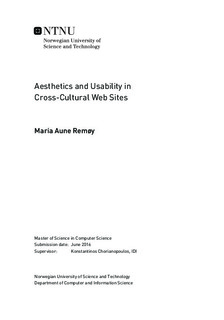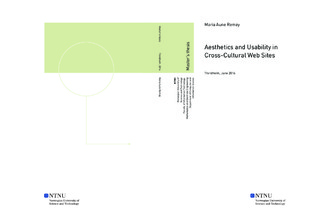| dc.description.abstract | Although the use of websites keeps increasing all over the world, many websites are not adapted to a global audience. For some time, the issue of how to localise websites have been researched. Moreover, the idea that culture can affect what users see as user-friendly and aesthetically beautiful is now considered to be true. This thesis challenges these ideas by doing a survey inspired by Tractinsky (1997). This study is a replica of an experiment by Kurosu and Kashimura (1995) but in a different cultural setting. The objective was to investigate the relationships between users perceptions of interface aesthetics and usability. Moreover, Tractinsky (1997) also examined the differences between his results and the results from Kurosu and Kashimura (1995) seen from a cultural perspective.
The research questions for this thesis are about whether users perception of beauty affects their perception of usability, and whether they perceive websites designed to fit their culture as more user-friendly or beautiful than other designs. A questionnaire consisting of six different website designs that were evaluated based on their beauty and perceived usability by people from several different countries was created to investigate these questions. For each design, an image was shown to the participant followed by 13 statements. The participant then rated the statements on a 7-point Likert scale from 1 (strongly disagree) to 7 (strongly agree).
For the first research question, the results of the study show that there is a link between the aesthetics of a design and the usability of the design, but this relationship is not strong enough to only rely on the aesthetics of the design when designing a user-friendly system. Moreover, it is not possible to use the results from this study to point out specific components in the design that influence the perceived usability in a specific way.
For the second and third research questions, the results showed that a user s cultural background does not seem to affect which design it prefers, both regarding the aesthetics and the usability. Also, the results indicate that which designs the participants liked varied both just as much inside each country as between countries.
Keywords: localization, website design, aesthetics, Hofstede s dimensions, usability. | |

